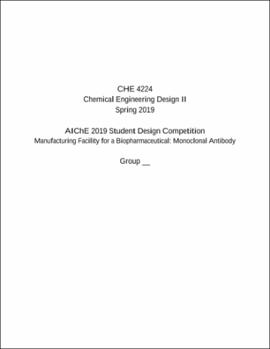| dc.contributor.author | Mackey, Jared | |
| dc.contributor.author | Peters, Reagan | |
| dc.date.accessioned | 2021-03-25T18:40:25Z | |
| dc.date.available | 2021-03-25T18:40:25Z | |
| dc.date.issued | 2019-05-10 | |
| dc.identifier | oksd_MackeyPeters_HT_2019 | |
| dc.identifier.uri | https://hdl.handle.net/11244/329055 | |
| dc.description.abstract | The objective of this design project was to determine the necessary process requirements in order to operate an industrial-scale Monoclonal Antibody (MAb) production facility. In addition, the economic value of this process was evaluated to ensure that the process is economically attractive and worth the potential investment. MAbs are primarily used for the treatment of cancer as will be the main function of MABs produced by this facility. With clinical studies in several areas of cancer currently being done by our company, as well as glaucoma and macular degeneration studies, there are several prospective uses of MAbs produced by this facility with the potential of new uses becoming available in the future. | |
| dc.description.abstract | The facility will require the purchase of media from an outside vendor and will then go through the designed process to produce the MAb product. The MAb can then be formulated and packaged to be sent to patients. Two different production options were evaluated to ensure plant flexibility with changing production requirements. One option produced concentrations of 1 to 2 g/L while the other produced concentrations of up to 10 g/L. | |
| dc.description.abstract | Currently, the process has a net present value (NPV) of $34.7 billion using a hurdle rate of 15%. The rate of return was found to be 7450%. The payback period is .02 years with capital costs of $38.5 million. Annual operating costs were found to be $20.2 million with an annual revenue of $7.37 billion. It was assumed that the MAb product was sold at $7150 per gram based on competitor market pricing and then marked down to avoid over-estimation. In order to breakeven, the MAb product needs to be sold for at least $56.60 per gram, which based on current market pricing is easily attainable. Economic evaluations were done on the conservative 1 to 2 g/L production basis and therefore the process can have even higher returns in the future if the production titer is changed up to 10 g/L. Due to the economic viability of this process, our design team recommends moving forward with the design and startup of this facility. | |
| dc.format | application/pdf | |
| dc.language | en_US | |
| dc.relation | oksd_black_HT_2019.pdf | |
| dc.relation | oksd_FinchEastepMullins_HT_2019.pdf | |
| dc.relation | oksd_macnaughton_HT_2019.pdf | |
| dc.rights | Copyright is held by the author who has granted the Oklahoma State University Library the non-exclusive right to share this material in its institutional repository. Contact Digital Library Services at lib-dls@okstate.edu or 405-744-9161 for the permission policy on the use, reproduction or distribution of this material. | |
| dc.title | AIChE 2019 Student Design Competition: Manufacturing facility for a biopharmaceutical: Monoclonal antibody | |
| osu.filename | oksd_MackeyPeters_HT_2019.pdf | |
| osu.accesstype | Open Access | |
| dc.type.genre | Honors Thesis | |
| dc.type.material | Text | |
| thesis.degree.discipline | Chemical Engineering | |
| thesis.degree.grantor | Oklahoma State University | |
